Walter Gabrielson
1935 - 2008
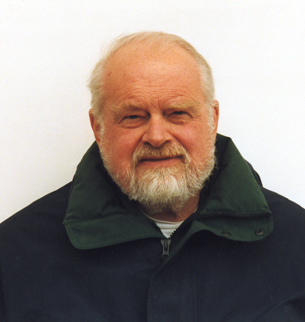
Suzanne Muchnic's Tribute published in the Los Angeles Times
Peter Plagens Tribute published on Artnet.com
-Persistance - Final Chapter - Epilogue
More to come……ms
Artist Walter Gabrielson dies at 73
His drawings, paintings and essays poked fun at the rigidity of art world trends and interpreted human behavior in luscious, well-designed visual essays and narrative pieces.
By Suzanne Muchnic
November 16, 2008
Walter Gabrielson, an artist, teacher and writer who interpreted human behavior in lusciously colored paintings and poked fun at the art world with vivid wit, has died. He was 73.
He died Wednesday night at Santa Barbara Cottage Hospital of complications from a rare form of anemia that he had endured for several years, said his wife, Nancy Goldberg.
"Art is my contribution and my experience with life. It just can't get much more intricate or more intense or more textural than that," Gabrielson wrote in his autobiography, self-published in 1993. Titled "Persistence" and described as "the ironic story of my survival in the Byzantine thickets of fine art," it's a rollicking, bittersweet tale of an artist who knew how to play by the rules but chose to go his own way. With a passion for flying, a love of cats and a curiosity about almost everything that moved or appeared in print, he became a compelling raconteur, whether expressing himself in words or pictures.
Gabrielson showed his paintings in dozens of galleries across the U.S. His works are in many public and private collections, including the Los Angeles County Museum of Art. But he was perpetually out of step with art trends and chafed against a system that had little room for narrative art.
In "Why Suck the Mainstream if You Don't Live in New York?," an essay published in Art in America in 1974, Gabrielson asked: "In this land of immense beauty and diversity, filled with characters, operators, canny inventors and dull middle classes, seething with incredibly complex human and resource pressures, spawning artists in tonnage figures, why, why should what is authenticated everywhere as art have all the excitement of coal production figures in Pravda or the art page of the good grey New York Times?"
"Timing is everything in the art world," said artist and critic Peter Plagens. "If Walter had emerged later, he would have gotten some traction. But his heyday was in the '70s, when everyone was either doing late Minimalism or digging ditches or painting big abstract paintings."
But many artists admired Gabrielson's talent as well as his warmth and wit.
"Walter was the best draftsman I ever encountered. The guy was really good," said Plagens, a longtime friend and teaching colleague. "When he boiled down social truths into paintings, they were always so well designed. And as a teacher, he was the king. His basic thesis -- and he enforced it with a kind of comedic, ironic rigor -- was that you had to find out who you were before you could make art." That approach was not fashionable, he said, "but Walter believed that your art came out of you personally, and you had to figure out who you were."
Gabrielson was born in the tiny town of Orr, Minn., in 1935 and lived there until 1953, when he enrolled at UCLA. He loved working as an editor, columnist and cartoonist for the school newspaper, the Daily Bruin, but graduated with a degree in economics in 1958. He spent the next two years in the Air Force, stationed at a radar site near Hanover, Germany.
Upon his return to Los Angeles in 1961, Gabrielson took classes at Chouinard Art Institute and supported himself by driving taxis at night. He transferred to Otis Art Institute, now Otis College of Art and Design, in 1963 and received a master's degree in painting and printmaking in 1965. While studying at Otis, he began working with artist June Wayne, who had established Tamarind Lithography Workshop with the help of a Ford Foundation grant. At Tamarind, he learned the art of stone lithography from master printer Ken Tyler and met an international array of prominent artists who made prints there.
Hired by San Fernando Valley State College, now Cal State Northridge, in 1966 to start a lithography department, Gabrielson taught art there until 1981. He lived in Pasadena throughout his teaching years, sharing a studio with Plagens for much of the time. Gabrielson set up a studio in downtown Los Angeles' burgeoning art district in the early 1980s, but in 1983, after being attacked on the street by thugs and suffering a heart attack, he moved to Santa Barbara and married Goldberg, an environmental consultant.
During his final years, he turned to the Internet as a forum for his art and writings and made paintings geared toward a broad audience.
In a statement prepared for his resume, Gabrielson wrote: "My purpose has always been to open up, to reveal what makes us tick and what is interesting, provocative and profound about us. All art is an attempt to create meaning, to expand our universe and to build a resonance with whatever public we can. I think my contribution is to be the best I can with the tools I have in the time I am operating to tell the stories that intrigue me."
In addition to his wife, he is survived by his mother, Marie Gabrielson of Santa Barbara, and sister, Judy Robertson of Cambria.
Muchnic is a Times staff writer.
suzanne.muchnic@
latimes.com
WALTER GABRIELSON,
1935-2008
by Peter Plagens
Walter Gabrielson, who died Nov. 12, 2008, in Santa Barbara, Ca., of complications from a rare form of anemia, at the age of 73, was the best draftsman and one of the best college art teachers around. If the fact that Walter was the best friend I ever had renders these judgments a little suspect to some, well screw it; I’m right.
I met Gabrielson in 1963 when, between years in grad school, I went back to Southern Cal to see if I could reclaim my old undergrad job in the psych department, drawing "stimuli" for "social intelligence" tests to be used by the Navy to see what kind of crew members could get along confined in submarines. Walter -- dog in the manger -- had taken my job. Fortunately, the project had grown enough to require two cartoonists. I settled into an adjacent cubicle. Thus began a drawing war of insulting cartoons folded into paper airplanes and sailed over the inter-cubicle wall. I loved the guy.
In 1969, after I’d been teaching in Texas and living for a bit in Europe, Walter got me a job (those were the days when a friend could get you a job) teaching with him in L.A. at what was then San Fernando Valley State College. (Now it’s Cal State, Northridge.) We shared an office and became known -- mostly favorably among the students, mostly unfavorably among the rest of the faculty -- as "The Pete ’n’ Wally Show." I was the aggressive, dogmatic abstract-painter-Artforum-writer "issues" fellow. (I’d contracted from John Coplans the idea that what good contemporary artists were supposed to do was to deal with "issues" left on the table by previous artists who’d dealt with "issues" left on the table by artists previous to them, and so on.) Walter was the "find out who you are first, then do art from that," unfashionably-social-comment painter. I’d go to New York three times a year, hobnob with the Artforum crowd, have a few drinks at Max’s Kansas City, visit some gritty post-Minimalist artists’ studios, and come back to Northridge with The Word. Walter would fly his little Aeronca Champion (later a Thorpe DB – 5) around the country to visit small-city museums and see paintings by Grant Wood and Thomas Hart Benton. He’d come back with a shitload of remarkable drawings. (Anyone who has a copy of one of Gabrielson’s two books of airplane drawings -- done by his alter-ego, "Pop Dawson," proprietor of Dawson Aircraft, whose motto, a parody of Zenith’s, was "The name goes on before the quality falls off" -- owns a real treasure.)
We shared a 3,000-square-foot amenity-less day studio in Pasadena for nine years, until I left Northridge in 1978. Walter, who played a mean piano and had forgotten more about classical music and jazz than I’ll ever know, was in charge of the sound system, such as it was: his huge, reel-to-reel tape recorder. In return, I got to keep all mail put through the slot addressed to "Occupant." We never argued about art, only whether a shot had clipped the edge of the ping-pong table he’d lugged up to the studio, or whether the cue ball had struck the wrong ball first in a game of coin-table pool at the really derelict Club 11 bar across the street. (The deceptively graceful, cherubic-physiqued, bearded-sea-cap’n Gabrielson was way better’n me at both games.)
If Walter had come along as an "emerging artist" in these days of Lisa Yuskavage, Elizabeth Peyton, Dana Schutz, et al., he might have made a killing. But he was in his prime in L.A. in the ’70s when abstraction, light & space, and installation and performance were in charge in the art world we cared about. (Oddly -- but perhaps not -- fellow pilot and artist Jim Turrell liked Walter’s extremely dissimilar work enough to have a two-person show with him at the ARCO Center for Visual Art, then the primo "alternative space" in town.) A vicious mugging near his downtown studio and the heart attack he suffered in the aftermath got him a medical leave from Northridge (which, truth be told, had treated him badly all those years by refusing to promote him from tenured assistant professor because he was such a thorn in the side of the art ed and commercial art types). He never went back, settling in Santa Barbara with his wonderful wife, Nancy Goldberg, and trying to live off his art.
It wasn’t easy. He ended up doing most of his business from his website, with some of the usual unsalutary consequences of having to make some of his paintings too accessible. But if you look at any of his pictures closely, you’ll see some of the best shape composition you’ve ever seen, some of the best deceptively normalized color you’ll ever see, some of the best edges you’ll ever see, some of the loveliest paint application you’ll ever see. . . and some of the best insights into American life you’ll ever see. They’re perhaps a little Saroyanesque for today’s taste for nastier satire, but they’re empathetic, generous and light-hearted while still being art with a lot of gravitas to it. And Walter could always be a little off the wall. I’ve got a drawing by him of William Bendix that I wouldn’t give up for anything. Oh, maybe I’d lend it to whoever does that posthumous retrospective that Walter’s art so richly deserves.
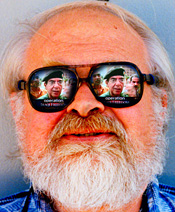
Walter Gabrielson
by Michael Speaker
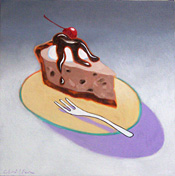
Walter Gabrielson's Chocolate Pie, from his "Great Eats" Series
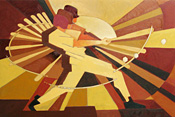
Walter Gabrielson's Out of the Park, From his Cubist Baseball Series
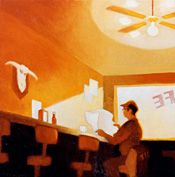
Walter Gabrielson's Morning Briefing, From his "Short Stories Series"